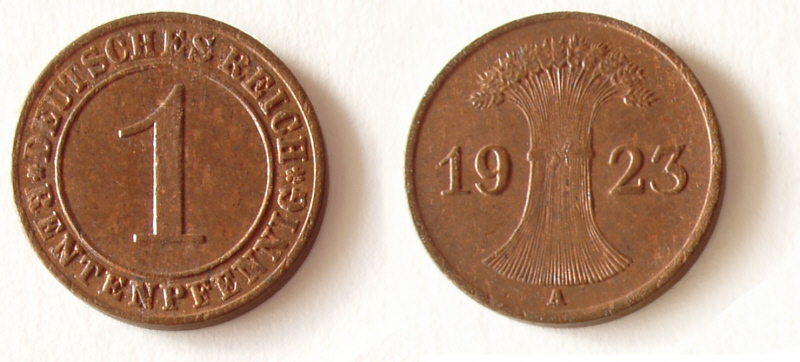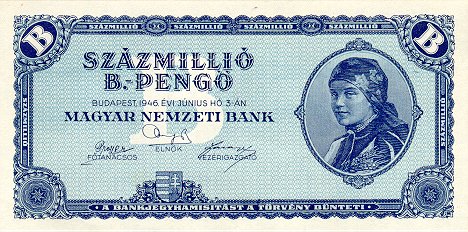|
Rentenbank
The Deutsche Rentenbank was a bank established in Germany by a regulation of 15 October 1923 as a state-owned monetary authority authorised to issue Rentenmark currency notes following the collapse of the private Reichsbank's Papiermark currency. The Rentenbank reserves consisted of mortgages against leading industrial properties and the German public accepted these reserves as being sound. This meant that the monetary crisis caused by the public's lack of confidence in the currency of the Reichsbank waned and the hyperinflation In economics, hyperinflation is a very high and typically accelerating inflation. It quickly erodes the real versus nominal value (economics), real value of the local currency, as the prices of all goods increase. This causes people to minimiz ... ceased. The Rentenmarks continued to be accepted as currency in Germany until 1947. References External links * Act creating the Deutschen RentenbanReichsgesetzblatt Teil I, 17 October 1923* Banks ... [...More Info...] [...Related Items...] OR: [Wikipedia] [Google] [Baidu] |
Rentenmark
The Rentenmark (; RM) was a currency issued on 15 November 1923 to stop the hyperinflation of 1922 and 1923 in Weimar Germany, after the previously used Papiermark had become almost worthless. It was subdivided into 100 ''Rentenpfennig'' and was replaced in 1924 by the Reichsmark. History After the Occupation of the Ruhr in early 1923 by French and Belgian troops, referred to as the ''Ruhrkampf'', the German government of Wilhelm Cuno reacted by announcing a policy of passive resistance. This caused the regional economy of the Ruhr, the industrial heartland of Germany, to almost stop. The occupation authorities reacted to strikes and sabotage with arrests and deportations. Those displaced and left without income by the ''Ruhrkampf'' and their families fell back on public income support. Tax revenues plunged as economic activity slowed. The government covered its need for funds mainly by printing money. As a result, inflation spiked and the Papiermark went into freefall on ... [...More Info...] [...Related Items...] OR: [Wikipedia] [Google] [Baidu] |
Reichsbank
The ''Reichsbank'' (; ) was the central bank of the German Empire from 1876 until the end of Nazi Germany in 1945. Background The monetary institutions in Germany had been unsuited for its economic development for several decades before unification. In the Kingdom of Prussia, the Bank of Prussia had been established in 1847 and, in the aftermath of the German revolutions of 1848–1849, revolution of 1848, five additional banks had been granted a note-issuance privilege (the , , , at Stettin, and ), but that was still insufficient to sustain adequate monetary conditions. By 1851, 9 banks in the whole of Germany (not including Austria) were chartered to issue banknotes, known as . In addition, most German states - with the only exceptions of Principality of Lippe, Lippe and the Hanseatic cities of Free City of Bremen, Bremen, Free City of Hamburg, Hamburg and Free City of Lübeck, Lübeck - issued government paper money without the intermediation of an issuing bank. Several pan- ... [...More Info...] [...Related Items...] OR: [Wikipedia] [Google] [Baidu] |
Germany
Germany, officially the Federal Republic of Germany, is a country in Central Europe. It lies between the Baltic Sea and the North Sea to the north and the Alps to the south. Its sixteen States of Germany, constituent states have a total population of over 84 million in an area of , making it the most populous member state of the European Union. It borders Denmark to the north, Poland and the Czech Republic to the east, Austria and Switzerland to the south, and France, Luxembourg, Belgium, and the Netherlands to the west. The Capital of Germany, nation's capital and List of cities in Germany by population, most populous city is Berlin and its main financial centre is Frankfurt; the largest urban area is the Ruhr. Settlement in the territory of modern Germany began in the Lower Paleolithic, with various tribes inhabiting it from the Neolithic onward, chiefly the Celts. Various Germanic peoples, Germanic tribes have inhabited the northern parts of modern Germany since classical ... [...More Info...] [...Related Items...] OR: [Wikipedia] [Google] [Baidu] |
Papiermark
The Papiermark (; 'paper mark') was a derisive term for the Mark (currency sign, sign: ℳ︁) after it went off the gold standard, and most specifically with the era of Hyperinflation in the Weimar Republic, hyperinflation in Germany of 1922 and 1923. Formally, the same German mark (1871), German mark was used from 1871 to 1923. Like many countries, Germany departed the gold standard due to the outbreak of World War I, and stopped issuing gold coins backed in marks in August 1914. Precious metals rapidly disappeared from circulation, and inflation occurred as paper money was used to cover war debts in 1914 to 1918. Still, the papiermark is more associated with the early Weimar Republic era, when inflation grew out of control. By the time the mark was retired from circulation and renominated in December 1923, banknotes had amounts in the billions and trillions of marks by face value. History From 1914, the value of the mark fell. The rate of inflation rose following the en ... [...More Info...] [...Related Items...] OR: [Wikipedia] [Google] [Baidu] |
Hyperinflation
In economics, hyperinflation is a very high and typically accelerating inflation. It quickly erodes the real versus nominal value (economics), real value of the local currency, as the prices of all goods increase. This causes people to minimize their holdings in that currency as they usually switch to more stable foreign currencies. Effective capital controls and currency substitution ("dollarization") are the orthodox solutions to ending short-term hyperinflation; however, there are significant social and economic costs to these policies. Ineffective implementations of these solutions often exacerbate the situation. Many governments choose to attempt to solve structural issues without resorting to those solutions, with the goal of bringing inflation down slowly while minimizing social costs of further economic shocks; however, this can lead to a prolonged period of high inflation. Unlike low inflation, where the process of rising prices is protracted and not generally noticeab ... [...More Info...] [...Related Items...] OR: [Wikipedia] [Google] [Baidu] |


